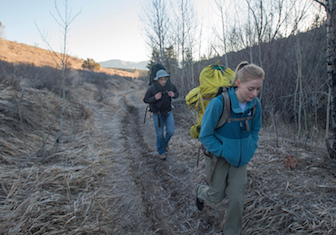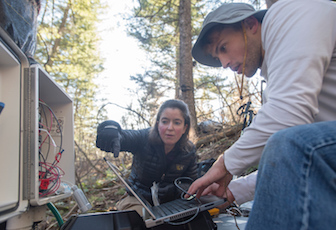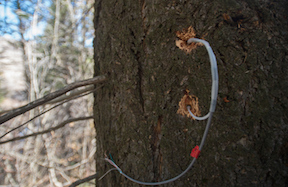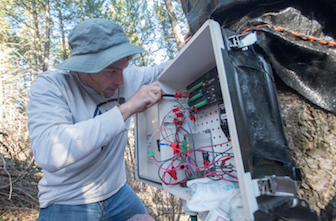Idaho State University Gibson Jack Creek RNA study on how plants process water has implications for climate change, water management
April 16, 2015
A solar panel sits near the top of a Douglas Fir tree about 70 feet off the ground somewhere on a steep ridge near Gibson Jack Creek, miles from the nearest trailhead.
“You know those things you enjoy as a child sometimes have applications afterwards,” said John Whiting, an Idaho State University geosciences master’s student, who has accompanied a group of ISU researchers to a study site where he climbed the tree and installed the solar panel about a year ago.
“I usually do the tree climbing, because I am most comfortable with it,” Whiting continued, “I am relatively safe and I usually use a harness, but Sarah doesn’t even like watching me install them.”
 He was referring to Sarah Godsey, an ISU geosciences assistant professor who is leading the study at U.S. Forest Service’s Gibson Jack Research Natural Area. In part, the study is one of the many facets of the National Science Foundations Managing Idaho’s Landscapes for Ecosystems Services (MILES) project that encompasses large regions of Idaho, focusing on the Portneuf, Boise and Coeur d’Alene River watersheds. Gibson Jack Creek is a tributary of the Portneuf River.
He was referring to Sarah Godsey, an ISU geosciences assistant professor who is leading the study at U.S. Forest Service’s Gibson Jack Research Natural Area. In part, the study is one of the many facets of the National Science Foundations Managing Idaho’s Landscapes for Ecosystems Services (MILES) project that encompasses large regions of Idaho, focusing on the Portneuf, Boise and Coeur d’Alene River watersheds. Gibson Jack Creek is a tributary of the Portneuf River.
The solar panel, along with some batteries that work when the panel isn’t producing energy, help power a variety of sensors that are set up in surrounding trees. These trees each feature ISU-crafted sap-flow sensors (made in part by hypodermic needles that are inserted into the sides of the trees) and the site also includes sensors that measure soil moisture, temperature, relative humidity and photosynthetically-activate radiation, or how much sunlight is available for trees to use.
There are a network of data cables from all of these sensors that lead into a protected plastic box hanging on the tree, where data is collected in a data logger, which is small device researchers can connect laptop computer to and download data.
 “The MILES grant covers ecosystems services, which is such a broad term, for all the benefits we get from the environment around us that we don’t pay for,” Godsey said. “In this particular part of the MILES project, we are looking at Gibson Jack and plant water use. We want to know how that can relate to stream flow and water quality.”
“The MILES grant covers ecosystems services, which is such a broad term, for all the benefits we get from the environment around us that we don’t pay for,” Godsey said. “In this particular part of the MILES project, we are looking at Gibson Jack and plant water use. We want to know how that can relate to stream flow and water quality.”
The researchers here are checking the water transpiration rates of the Douglas Fir trees, measuring the amount of water released by the trees into the air.
“In the overall big picture, the importance of transpiration has to with the water balance, or how much water is flowing in and flowing out of a watershed,” Godsey said. “About two-thirds of water from either rain or snow is usually lost to the atmosphere from evaporation or through the transpiration of plants, and the rest of it goes to feed streams. As far as water management is concerned, it is important to take in consideration the water losses by plants, and how that might change with variations in climate and weather.”
 On this trip, the researchers – also including Dylan Refaey, an ISU junior studying earth and environmental systems who is a MILES undergraduate research intern, and Clarissa Enslin, a geosciences master’s student working primarily on snowpacks on a different grant – are attempting to download data from the site, check its sensors and are also hauling four backpacks full of other equipment to a new site, located further up the ridge. Eventually, the researchers will set up three sites located at low, medium, and high elevations.
On this trip, the researchers – also including Dylan Refaey, an ISU junior studying earth and environmental systems who is a MILES undergraduate research intern, and Clarissa Enslin, a geosciences master’s student working primarily on snowpacks on a different grant – are attempting to download data from the site, check its sensors and are also hauling four backpacks full of other equipment to a new site, located further up the ridge. Eventually, the researchers will set up three sites located at low, medium, and high elevations.
“Our original hypothesis that led us to this study is that plant water use in rain-dominated low elevations will be different of that in snow-dominated elevations and that could have important implications for water storage,” Godsey said. “If the amount changes or the timing of flows through the trees changes, we might have streams that dry up that used to flow year-around or vice versa. Part of the MILES grant is to understand how to manage our landscapes for ecosystem services like stream flow.”
 The research site has uses beyond the scope it is being used for the MILES grant. The site has been used by geosciences and biological sciences for class field trips and will be used by for a two-week field class this summer. The site was also used by Whiting last spring to prepare him to set up similar sites and complete a similar study in the Frank Church River of No Wilderness Area last summer.
The research site has uses beyond the scope it is being used for the MILES grant. The site has been used by geosciences and biological sciences for class field trips and will be used by for a two-week field class this summer. The site was also used by Whiting last spring to prepare him to set up similar sites and complete a similar study in the Frank Church River of No Wilderness Area last summer.
The project as a whole offers other, sometimes intangible, values.
“I’ve been really pleased with the research opportunities I’ve received at ISU,” said Refaey who, as part of his MILES MURI internship, has constructed the sap-flow sensors for this project. “This internship has opened up a lot of doors for me and opened my eyes to other fields in environmental and earth sciences. Originally, I hadn’t planned to go on with my education and get a master’s or anything, but after this internship and working with Sarah, John and other people at ISU, it has motivated me to keep going with my education and get a master’s.”
More information on the MILES grant is available at www.idahoecosystems.org.
MILES is receiving input for researchers from a variety of academic disciplines from ISU, Boise State University and the University of Idaho. The five-year, $20 million grant is funded by the NSF’s Experimental Program to Stimulate Competitive Research (EPSCoR).
Categories:
